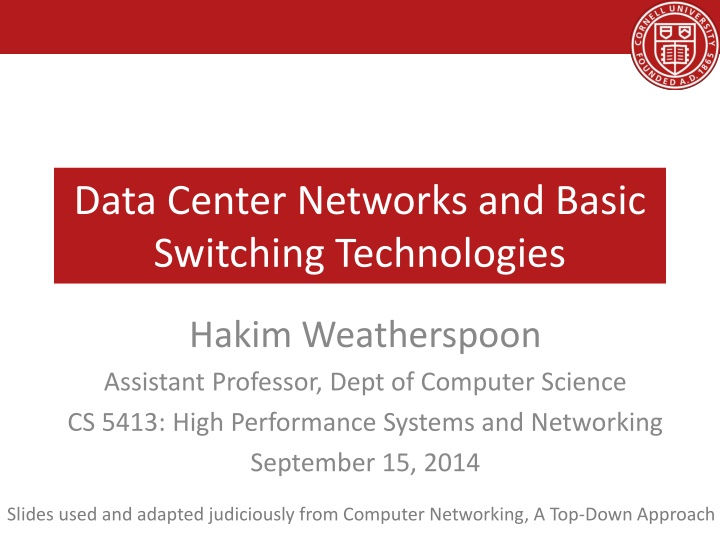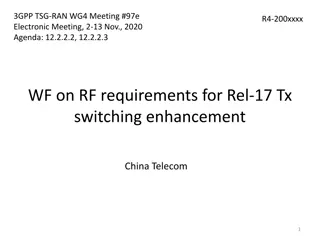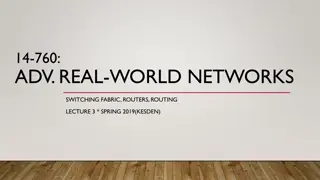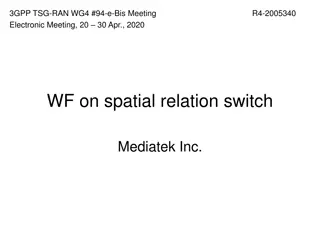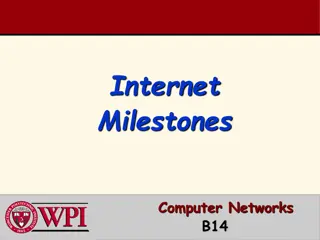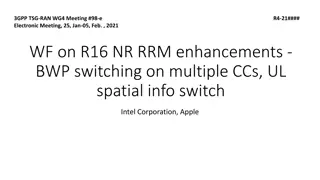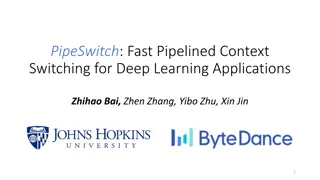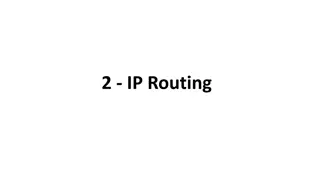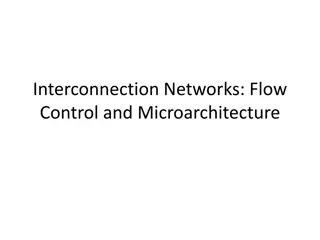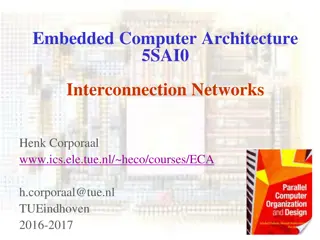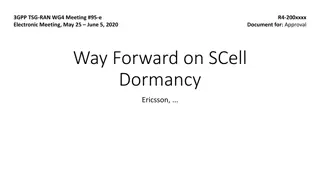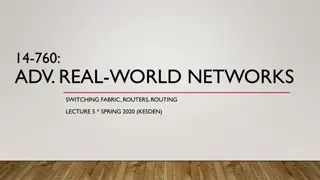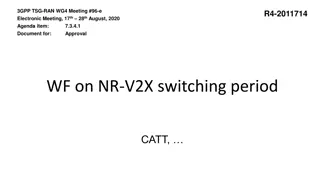Data Center Networks and Switching Technologies Overview
Delve into the foundational aspects of data center networks and basic switching technologies as presented by Assistant Professor Hakim Weatherspoon. Explore the slides compiled and adapted from the source "Computer Networking: A Top-Down Approach," covering critical concepts in high-performance systems and networking.
Uploaded on Mar 02, 2025 | 2 Views
Download Presentation

Please find below an Image/Link to download the presentation.
The content on the website is provided AS IS for your information and personal use only. It may not be sold, licensed, or shared on other websites without obtaining consent from the author.If you encounter any issues during the download, it is possible that the publisher has removed the file from their server.
You are allowed to download the files provided on this website for personal or commercial use, subject to the condition that they are used lawfully. All files are the property of their respective owners.
The content on the website is provided AS IS for your information and personal use only. It may not be sold, licensed, or shared on other websites without obtaining consent from the author.
E N D
Presentation Transcript
Data Center Networks and Basic Switching Technologies Hakim Weatherspoon Assistant Professor, Dept of Computer Science CS 5413: High Performance Systems and Networking September 15, 2014 Slides used and adapted judiciously from Computer Networking, A Top-Down Approach
Where are we in the semester? Overview and Basics Data Center Networks Basic switching technologies (today) Data Center Network Topologies Software Routers (eg. Click, Routebricks, NetMap, Netslice) Alternative Switching Technologies Data Center Transport Data Center Software Networking Software Defined networking (overview, control plane, data plane, NetFGPA) Data Center Traffic and Measurements Virtualizing Networks Middleboxes Advanced Topics
Goals for Today Basic Switching Technologies/Router Architecture Overview See Section 4.3 in book A 50-Gb/s IP Router Craig Partridge , Senior Member , Philip P. Carvey , Isidro Castineyra , Tom Clarke , John Rokosz , Joshua Seeger , Michael Sollins , Steve Starch , Benjamin Tober , Gregory D. Troxel , David Waitzman , Scott Winterble. IEEE/ACM Transactions on Networking (ToN), Volume 6, Issue 3 (June 1998), pages 237-248.
Router Architecture Overview two key router functions: run routing algorithms/protocol (e.g. RIP, OSPF, BGP) forwarding datagrams from incoming to outgoing link routing processor forwarding tables computed, pushed to input ports routing, management control plane (software) forwarding data plane (hardware) high-seed switching fabric router input ports router output ports
Router Architecture Overview Input Port Functions lookup, forwarding link layer protocol (receive) switch fabric line termination queueing physical layer: bit-level reception data link layer: e.g., Ethernet see chapter 5 decentralized switching: given datagram dest., lookup output port using forwarding table in input port memory ( match plus action ) goal: complete input port processing at line speed queuing: if datagrams arrive faster than forwarding rate into switch fabric
Router Architecture Overview Switching Fabrics transfer packet from input buffer to appropriate output buffer switching rate: rate at which packets can be transfered from inputs to outputs often measured as multiple of input/output line rate N inputs: switching rate N times line rate desirable three types of switching fabrics memory bus memory crossbar
Router Architecture Overview Switching via Memory: First Generation Routers traditional computers with switching under direct control of CPU packet copied to system s memory speed limited by memory bandwidth (2 bus crossings per datagram) output port (e.g., Ethernet) input port (e.g., Ethernet) memory system bus
Router Architecture Overview Switching via a bus datagram from input port memory to output port memory via a shared bus bus contention: switching speed limited by bus bandwidth 32 Gbps bus, Cisco 5600: sufficient speed for access and enterprise routers bus
Router Architecture Overview Switching via interconnection network overcome bus bandwidth limitations banyan networks, crossbar, other interconnection nets initially developed to connect processors in multiprocessor advanced design: fragmenting datagram into fixed length cells, switch cells through the fabric. Cisco 12000: switches 60 Gbps through the interconnection network crossbar
Router Architecture Overview Output Ports datagram buffer link layer protocol (send) switch fabric line termination queueing buffering required when datagrams arrive from fabric faster than the transmission rate scheduling discipline chooses among queued datagrams for transmission
Router Architecture Overview Output Port Queuing switch fabric switch fabric one packet time later at t, packets more from input to output buffering when arrival rate via switch exceeds output line speed queueing (delay) and loss due to output port buffer overflow!
Router Architecture Overview How much buffering? RFC 3439 rule of thumb: average buffering equal to typical RTT (say 250 msec) times link capacity C e.g., C = 10 Gpbs link: 2.5 Gbit buffer recent recommendation: with N flows, buffering equal to RTT C . N
Router Architecture Overview Input Port Queuing fabric slower than input ports combined -> queueing may occur at input queues queueing delay and loss due to input buffer overflow! Head-of-the-Line (HOL) blocking: queued datagram at front of queue prevents others in queue from moving forward switch fabric switch fabric output port contention: only one red datagram can be transferred. lower red packet is blocked one packet time later: green packet experiences HOL blocking
Goals for Today Basic Switching Technologies/Router Architecture Overview See Section 4.3 in book A 50-Gb/s IP Router Craig Partridge , Senior Member , Philip P. Carvey , Isidro Castineyra , Tom Clarke , John Rokosz , Joshua Seeger , Michael Sollins , Steve Starch , Benjamin Tober , Gregory D. Troxel , David Waitzman , Scott Winterble. IEEE/ACM Transactions on Networking (ToN), Volume 6, Issue 3 (June 1998), pages 237-248.
Multigigabit Router (MGR) Architecture Network interfaces (Line cards) Forwarding Engine Network Processor Switching Fabric .
Multigigabit Router (MGR) Contributions Network interfaces (Line cards) Forwarding Engine distinct from line cards Forwarding Engine Complete set of forwarding tables, fast path QoS Network Processor Updates Routing Table Separates and handles slow path Switching Fabric Switched backplane
Goals for Today Basic Switching Technologies/Router Architecture Overview See Section 4.3 in book A 50-Gb/s IP Router Craig Partridge , Senior Member , Philip P. Carvey , Isidro Castineyra , Tom Clarke , John Rokosz , Joshua Seeger , Michael Sollins , Steve Starch , Benjamin Tober , Gregory D. Troxel , David Waitzman , Scott Winterble. IEEE/ACM Transactions on Networking (ToN), Volume 6, Issue 3 (June 1998), pages 237-248.
Before Next time Project Proposal due this Friday, Sept 19 Meet with groups, TA, and professor Lab2 Multi threaded TCP proxy Due this Friday, Sept 19 Required review and reading A Guided Tour Through Datacenter Networking, D. Abts and B. Felderman. Communications of the ACM (CACM), Volume 55, Issue 6 (June 2012), pages 44- 51. http://dl.acm.org/citation.cfm?id=2184335 http://wwwnew.cs.princeton.edu/courses/archive/spring13/cos598C/google- network.pdf Check piazza: http://piazza.com/cornell/fall2014/cs5413 Check website for updated schedule
